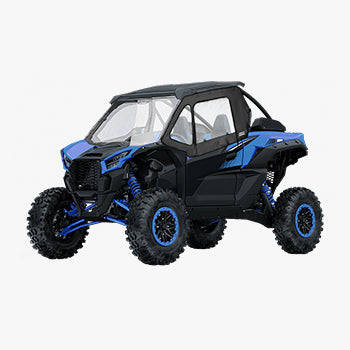How to Protect Your Boat from Dock Damage?

If you're anything like us, your boat is more than just a way to get from point A to point B on the water—it's an extension of who you are. Whether it's a sleek speedboat or a trusty fishing vessel, boats require some TLC, especially when it comes to docking. Let's face it: docks can be harsh environments. Between the wind, waves, and the occasional inconsiderate neighbor, there's plenty that can go wrong.
In this blog, we'll dive into how to protect your beloved boat from dock damage. From essential gear to best practices, we've got you covered. Let's get it started!
Understanding the Threats
Before we jump into solutions, it’s crucial to understand what exactly we're up against. Docks can pose several threats to your boat:
-
Physical Contact: Constant bumping against the dock can scratch or dent your boat.
-
Weather Conditions: Wind, waves, and tides can push your boat into the dock, causing potential damage.
-
Mooring Line Failure: Poor-quality ropes or improper tying techniques can result in your boat drifting away or slamming into the dock.
Now that we know what we’re dealing with, let’s look at ways to keep your boat safe.
4 Essential Gear for Docking
First things first—gear up! The right equipment can make all the difference in keeping your boat protected.
Fenders

Boat fenders act as cushions between your boat and the dock, absorbing impact and preventing damage. Here are some tips:
- Size Matters: Choose fenders that are proportional to your boat. Too small, and they won’t provide enough protection; too large, and they could be cumbersome. For boats like fishing boats, pontoon boats, jet boats, and other types that are between 10 and 30 feet long, go for fenders around 5.5 to 8 inches in diameter.
- Placement: Place fenders at points where your boat makes contact with the dock. Typically, this means along the sides but may also include the bow and stern depending on the layout of the dock.
- Maintenance: Regularly check your fenders for wear and tear. Replace them if they start to show signs of aging.
Mooring Lines
Good quality mooring lines are essential for securing your boat to the dock. Here's what to consider:
- Material: Nylon ropes are popular because they are strong and stretchy to absorb shock.
- Length: Use mooring lines around two-thirds the length of your boat. This way, they’ll be long enough to handle tide and water level changes without getting tangled or causing tripping issues.
- Knots: Learn and use proper knots, such as the cleat hitch, bowline, and figure-eight knot, to ensure your boat stays secure.
Dock Cleats and Bollards
Ensure the dock has sturdy cleats and bollards for you to tie up to. Weak or poorly maintained hardware can be a recipe for disaster.
Dock Lines and Snubbers
Using dock lines and snubbers will help manage the forces exerted by waves and wind. Snubbers offer elasticity, allowing them to absorb shock and reduce stress on your boat and dock lines.
6 Best Practices for Docking to Prevent Boat Damage

Having the right gear is only half the battle. Knowing how to use it effectively is key to protecting your boat from dock.
1. Approach Slowly
When approaching the dock, slow and steady wins the race. A gentle approach gives you more control and minimizes the risk of collisions. Use your boat's momentum and adjust with reverse thrust as needed.
2. Angle of Approach
The angle at which you approach the dock can make docking easier and safer. A 30 to 45° angle allows you to get close without risking a head-on collision. Once near, shift to neutral and use short bursts of power to maneuver.
3. Secure the Bow First
Start by securing the bow line. This will help prevent the boat from drifting away from the dock as you secure the stern. Once the bow is secure, move to the stern and finish tying up.
4. Adjust for Weather Conditions
Wind and currents can make docking tricky, so remember this:
- If the wind is against you: Go slow and let the wind help guide you to the dock.
- If the wind is behind you: Move in a bit quicker to stay in control because the wind will try to push you away from the dock.
5. Use Spring Lines
Spring lines run diagonally from the boat to the dock and help control movement forward and backward. They’re particularly useful for keeping your boat stable in changing conditions.
6. Check Frequently
Regularly inspect your mooring lines, fenders, and other protective measures. Conditions can change quickly, and staying vigilant can prevent minor issues from becoming major problems.
Additional Tips and Tricks
Here are some extra pointers to take your boat protection game to the next level:
-
Install Dock Bumpers
Dock bumpers are installed on the dock itself rather than on your boat. These padded attachments add another layer of protection and are especially useful for frequently used docks.

-
Use a Boat Cover
A good boat cover can protect your vessel from UV rays, rain, and debris while it’s docked. Look for covers made from durable material that fits your boat snugly.
-
Regular Maintenance
Regularly maintain both your boat and dock. Look out for loose boards, nails sticking out, or any other hazards on the dock. As for your boat, routine checks of the hull, motor, and other components can catch issues before they become serious.
-
Community Communication
If you share a dock with others, communicate clearly about expected behaviors and any issues you notice. Cooperation and courtesy go a long way in helping keep the place safe for everyone.
-
Emergency Preparedness
Have a plan in place for extreme weather events. Know how to quickly and safely evacuate your boat from the dock if necessary. Keeping emergency supplies and equipment onboard can also be a lifesaver.
Final Thoughts
So, here’s to smooth sailing and safe docking!
By knowing the risks, using good fenders and essential boat equipment, and following the smart practices mentioned above, you can keep both your boat and the dock in top shape.
Remember, your boat is a big investment. Taking the time to protect it not only keeps its value up but also means more fun times on the water. Want more ways to protect your boat? Check out Kemimoto's easy-to-use and durable boat accessories to keep your boat safe!













Dejar un comentario